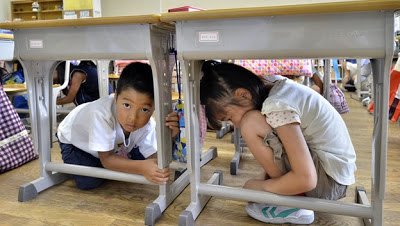What to do in case of an earthquake. Guide for teachers.
Earthquakes are unexpected events, which occur when rocks form the earth's crust, bounce off suddenly, due to the forces that compress them. An earthquake can occur at any time, mainly in places near tectonic faults. We must all be prepared to face an earthquake, but teachers, who work with children and young people, must be specially prepared to act appropriately in the event of an earthquake in order to avoid injuries or human losses among students and school staff. For all this, it is necessary to take into account the measures to be taken before, during and after the earthquake.

http://todo-sobre-sismos.blogspot.com/2016/10/simulacro-en-la-escuela-simulacro.html
Before the earthquake. As a teacher, you always have to be prepared, because there is no way to know when an earthquake will occur. For this, there must be a preparation program for teachers and students in every school. The teacher has a preponderant role in the seismic prevention within the school, collaborating and participating in the simulations and preparation speeches for students and teachers that must be carried out periodically. You must know the escape routes, which must be posted in a visible place in each classroom and in the corridors and external areas. In addition, a helmet must be available for the teacher in each classroom. The teacher must know and put into practice what they have learned about how to act before, during and after an earthquake, know the location of water access keys, electrical boxes, fire extinguishers and fire hoses in school. Inside the classroom, heavy shelves should be bolted to the wall.

https://www.raymac.co.uk/resources/images
During the earthquake. The first and most important rule is keeping calm. This is basic if we are teachers, it will help to calm our students. As you feel an earthquake is occurring, it must be indicated aloud, for example with the phrase "it’s shaking" and the students must comply with the second rule: bend, cover and hold. If they are inside the classroom, must bend over to get under their work table; keep at least the head under the table, and hold both hands on the legs of the table. It is important that no student leave the classroom until the teacher indicates that the earthquake is over. If you are in corridors or patios, teachers and students must cover their heads with both arms and bend over until shaking ends. In any case, it is important nobody stays near windows, bookshelves or shelves that could fall.

https://mundofili.blogspot.com/2012/11/como-preparar-los-ninos-para-enfrentar.html After the earthquake. As soon as the earthquake ends, you should leave the classroom calmly with your students, without running, and go to an open area. If you must use stairs, walk down, do not run. The open area must be known thru the school evacuation plan. It may be a playground, parking lot, or an open area at or near the school that poses no danger to students and school personnel. The length of stay of students and staff in this area will vary according to the severity of the seismic event. The teacher must keep their students together during the stay in the open area, until they authorize their return to the building or the abandonment of it and assess the status of their students.

excellent post
Excelente post, la preparación y prevención siempre es muy importante ante este tipo de emergencias y es muy bueno siempre recordarlo, o que nos recuerden, un tip, puedes colocar reseña a las imágenes que consigues por internet, colocando la palabra "fuente" entre [ ] y el link entre paréntesis, para que quede algo como esto: fuente, lo cual es un hipervinculo directo al link, muchos saludos =)
Gracias por el dato!
Bien documentado este post. Excelente